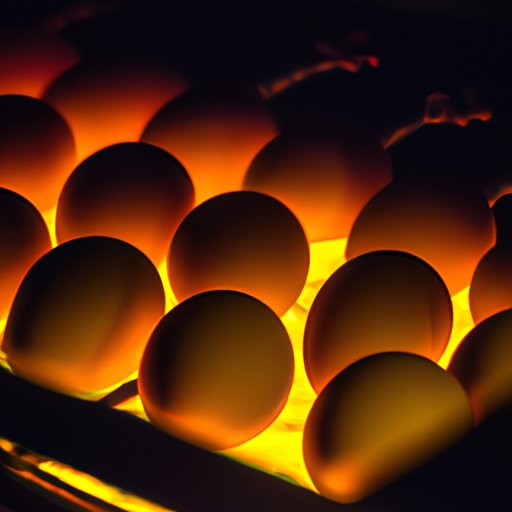
I. Introduction
Egg candling is the process of passing a bright light through an egg to visually inspect its contents. This technique is widely used in hatcheries and among at-home incubator enthusiasts to assess the egg’s development. Candling can reveal whether an egg is fertilized, detect any defects or cracks, and check the growth of embryos. If you’re new to egg candling, this guide will provide you with step-by-step instructions to help you start. Learning how to properly candle an egg is critical if you’re caring for hatching eggs or breeding chickens or other poultry.
II. Step-by-Step Guide: How to Properly Candle an Egg
Before you begin candling, you’ll need a few specific items, such as a bright light source, a dark room, and a piece of cardboard with a hole in it. The cardboard can be of any size and thickness, just make sure the hole is slightly smaller than the width of an egg. Here’s how it’s done:
- Choose a fresh, clean egg from your collection.
- Turn off all lights in the room, and illuminate the area with a bright flashlight or a candling lamp.
- Hold the egg against the hole in the cardboard at an angle, with the pointy end facing downwards.
- Turn the egg slowly, so that the entire surface inside the shell can be seen.
- Observe the contents of the egg closely. A fertilized egg would show growth, which would look like veining or red or orange shadows, while an unfertilized egg would be transparent and clear.
- Check the eggshell for any cracks, deformities, or other abnormalities that may affect hatchability or freshness.
After candling, replace the egg in the incubator or return it to the hen to continue the hatching process.
III. The Importance of Candling Eggs in Incubation and How to Do It
Candling is a crucial step in the incubation process that helps you detect problems early on. During egg development, there are several stages that the egg passes through. Candling allows you to monitor the development of the egg, ensuring that it is progressing as it should.
To begin the candling process, wait for the embryo to develop sufficiently. At around day 5 of incubation, you should be able to see the beginning of embryo growth. This is the point where you should start candling and tracking the progress.
There are three types of candling techniques:
- Candling to check the egg’s fertility
- Candling during the early stage of incubation
- Candling during the second half of incubation to check for malpositions or unhealthy eggs
IV. Candling Eggs: A Beginner’s Guide
If you’re new to candling, it may seem daunting. But with the help of this guide, you’ll be able to get started and become a pro in no time. Here are some things you should keep in mind:
Before you start, you’ll need to have the following tools:
- A flashlight or other bright light source
- An incubator or a broody hen
- A cardboard box or other dark enclosure
- A clean, warm, and comfortable spot to work in
If you’re using an incubator, you should candle your eggs at least three times during the incubation period, around day 5, day 12, and day 18. This will help you monitor the egg’s development and detect any problems that may arise.
During candling, hold the egg delicately and don’t shake it too hard. The embryo is alive and fragile, and excessive jostling can be harmful. As you practice candling, you will find that you become more skilled at it.
Familiarize yourself with common problems faced while candling eggs. Issues such as stringy egg white, blood rings, or rotten eggs need to be identified at the earliest to prevent contamination and possible fertility issues in the future.
V. Egg Candling Methods: Traditional vs Modern Techniques
There are two main types of egg candling techniques; traditional and modern. Traditional methods use a candle or another light source, while modern techniques employ more advanced technology, like a UV light or an egg candler.
Both techniques have their advantages and disadvantages. Traditional candle lighting is less expensive and more readily available, while the modern method is more accurate. You should choose the method that best suits your needs and budget.
When choosing between traditional and modern candling techniques, consider how much time and effort you’re willing to invest in the process, your experience level, and your budget.
VI. Tips and Tricks for Successful Egg Candling
Here are a few tips to help you reach a higher level of success while candling eggs:
- Choose a dark and comfortable location for candling the eggs.
- A battery-operated lantern is a good choice for lighting the eggs
- Make sure the room light does not compromise the egg’s vision.
- Always hold the egg gently during the candling process.
- Familiarize yourself with the different developmental stages of an egg.
VII. Common Mistakes to Avoid When Candling Eggs at Home
Candling eggs at home is a delicate process, and several mistakes can compromise the eggs’ health. Here are some common mistakes to avoid during the egg candling process:
- Shining light onto eggs that are too old to hatch
- Not being gentle while handling eggs during the candling process
- Candling the eggs too frequently
- Not knowing what to look for during the candling process
VIII. Conclusion
Candling an egg is a critical process for hatcheries and those raising poultry. With the appropriate tools and knowledge, anyone can start candling their eggs at home. By following the proper procedure and taking precautions, egg candling can help you achieve a more successful hatch rate. Give it a try and see the vast difference in raising your poultry or hatching rate.





